Health authorities on Thursday announced that Los Angeles County has likely passed the peak of omicron transmission, but warned that hospitals remain strained.
Several COVID-19 metrics are showing declines, including daily case and positivity rates.
With 4,323 people hospitalized with COVID-19 Thursday — down from a peak of 4,800 patients last week — officials said hospitalizations also appear to be declining.
The seven-day average of new hospital admissions has decreased by 10%.
The county confirmed 26,010 new coronavirus cases Thursday, marking a stark contrast from earlier this month, when the county saw record-shattering daily case numbers topping 45,500 thanks to an omicron variant -fueled surge.
The county’s daily case numbers have remained below 30,000 during the past six days.
“We are finally turning a corner on this surge,” L.A. County Health Director Barbara Ferrer said earlier this week.
Still, concerns remain about hospitals in the county struggling with staffing shortages.
“The county’s healthcare system remains under strain due to more healthcare workers testing positive, which is contributing to the shortage of healthcare workers across the county,” the L.A. County Department of Public Health said.

During the week of Jan. 14, 1,559 more health care worker tested positive for the virus — a nearly 18% increase compared to the week before.
“While these declines give us cause for much welcomed hope, we should not take them as a sign to forgo the commonsense protective measures that helped to slow COVID-19 transmission in our county,” Ferrer said. “Continuing these safety measures will drive down cases, which will ultimately end staffing shortages, reduce workplace and school outbreaks, and most importantly, keep residents from becoming seriously ill and dying.”
The surge has so far disproportionately affected unvaccinated people, officials said.
Over the past two months, the risk of hospitalization was significantly lower for those who were fully vaccinated and boosted.
Fully vaccinated and boosted people were 28 times less likely to be admitted to the ICU for COVID-19 than those who were unvaccinated, the health department said, citing data collected through Jan. 15.
Health officials said this shows that vaccines continue to provide the best protection against severe illness from COVID-19.
The availability of vaccines has also meant that officials didn’t respond to the latest surge with business closures and capacity limits.
“Even during the surge, it’s been possible to continue many of our customary activities if we layer in all of the protections now available and take personal responsibility for recognizing our role in reducing transmission, protecting those we love, and protecting those most vulnerable,” Ferrer said earlier this week.
Residents were urged to get vaccinated and boosted, adhere to masking requirements when indoors or at crowded spaces and stay home when sick.
















